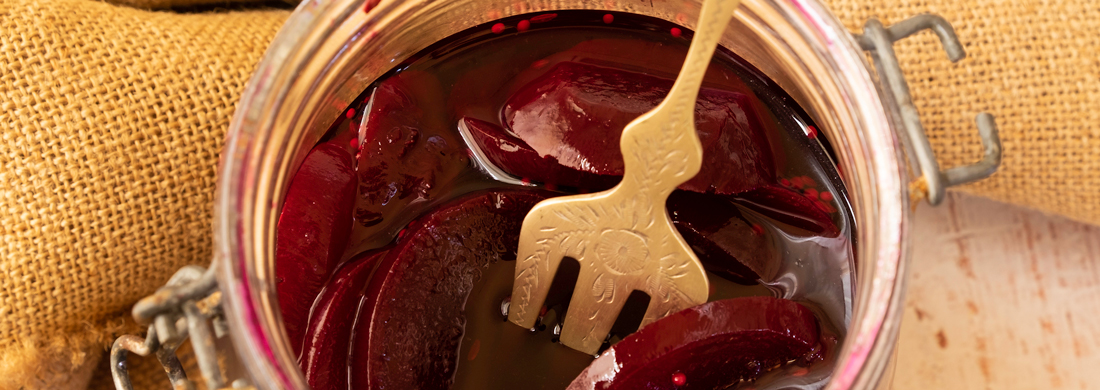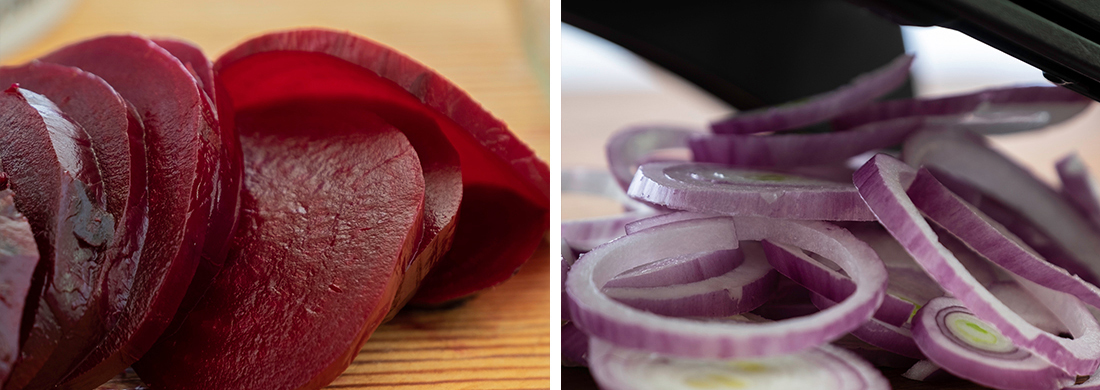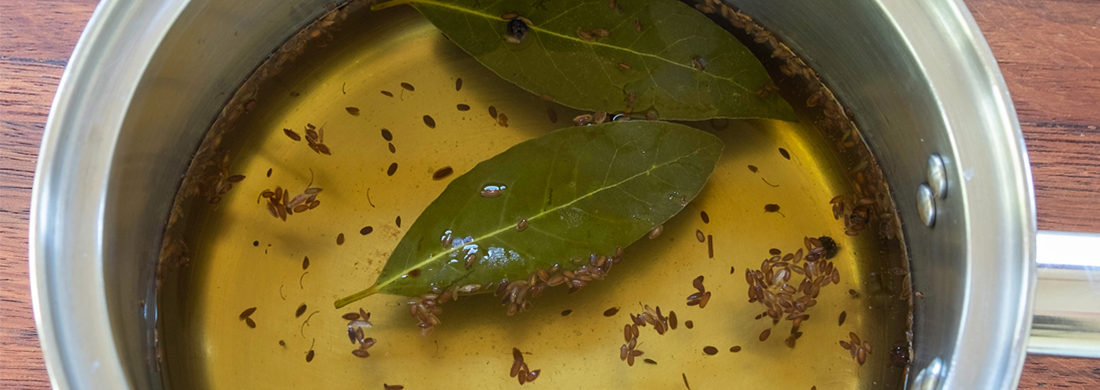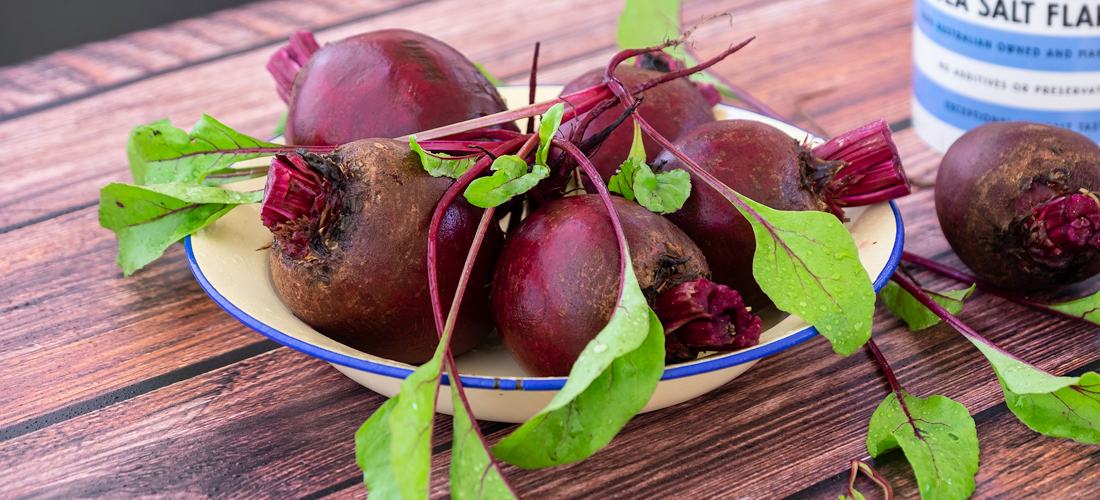Pickled Dilly Beetroot
- Pickles, Chutney, Relish & Sauces

Beetroot and dill are one of the great flavour combinations. Beetroot’s earthy flavour pairs with dill’s slightly menthol and mild anise-like liquorice flavours. Give your next pickled beetroot a boost with dill seeds and allow the flavours to marry over time. Easy to make and quick to prepare, this recipe will soon become a family favourite. It’s delicious in salads and as an accompaniment to smoked and cured fish, goats’ cheese and of course the ubiquitous burger in any of its incarnations – plant or meat based. Caraway seeds, which have a similar but milder flavour can be substituted for the dill.
- Preparation Time:
- 20 minutes
- Cooking Time:
- 40-50 minutes
- Quantity:
- 2 x 750 ml jars
PREPARATION
Sterilise good quality glass jars with sealable lids
While the beets are cooking in the oven, make the spiced vinegar and wash and sterilise the jars

INGREDIENTS
- 1 kg
- Beetroot, fresh, medium sized
- 2
- Red onions, peeled, medium
- 1 litre
- Apple cider vinegar
- 1 teaspoon
- Salt, preserving
- 200g
- Sugar, white
- 3 teaspoons
- Dill seeds, whole
- 2
- Bay leaves, fresh
- 4
- Black peppercorns, whole
- 2
- Allspice berries, whole
METHOD
Wash the beetroot to remove any excess dirt and remove the leaves. Do not peel.
Wrap each beetroot individually in cooking foil, place in an oven-proof tray and bake, for approximately 40 minutes, in the moderate oven, until cooked. The time will depend upon the size of the beetroots.
Remove from the oven and allow to cool enough to handle.
Remove the cooking foil. Wearing disposable food grade gloves, gently rub the skin off with your hands. Discard the foil and beetroot skin.
Place vinegar, sugar ,salt, bay leaves, black peppercorns, allspice berries and dill or caraway seeds into to a saucepan and place on medium heat. Stir occasionally and cook until the sugar has dissolved. Remove from the heat, strain, and allow to cool slightly. Discard the strained seeds.
Slice the peeled beetroot and red onion into 3cm rounds. If the beetroots are large cut them in half first. They need to be easy to get into/out of the jar. Alternating layers of beetroot and onions in the dry warm sterilised jars fill to 5cm ( 2inches) from the top of the jar.
Cover the beetroot and onion with the vinegar mixture. Seal and store for 3 weeks before using. Store in the fridge.

NOTES
- Thoroughly wash the beetroot to remove any garden debris or soil before preparing.
- Do not use old, overripe, or mouldy beetroot as this will produce a poor-quality preserve.
- Leaving the skin on the beetroot and cooking in the foil in the oven will intensify the flavour of the beetroot and reduce any colour loss. Some recipes boil the beetroot. I prefer the oven cook method as colour and flavour ends up in the water, which is then disposed, in the boiling method.
- The time to cook the beetroot will vary depending on the size. To test if they are cooked, pierce with a cake skewer. There should be no resistance.
- The food safe gloves will protect the absorption of red beetroot juice and subsequent staining of your hands.
- Use a good quality sea salt, unrefined, where possible, when preserving. It’s worth hunting around for. Table salt, which is cheap and readily available in supermarkets contains stabilisers and anti-caking agents and often iodide which forms a whitish haze and sediments in pickled vegetable recipes. These additives and in particular iodine can affect the appearance and taste of pickles during the maturation and storage period. The ingestion of a cocktail of anti-caking chemicals such as calcium silicate, sodium silicoaluminate, tricalcium phosphate, magnesium carbonate, silicon dioxide and yellow prussiate of soda, is also unnecessary. Lite Salt may be used in quick pickle recipes; however, it may result in a slightly different taste than expected.
- The natural calcium and magnesium impurities of unrefined sea salt helps to cross link and reinforce the cell wall pectin’s, creating a crisp pickle.
- I use a mandoline to slice the beetroot and oions, so they are the same width.
- Once all the beetroot has been eaten, save the vinegar and use to make pickled eggs. The eggs will absorb the beetroot colouring. Presented on the table, in a salad, on a ploughman’s lunch or however you serve pickled eggs, visually they will take on an exciting new dimension.
- White sugar can be substituted with raw sugar. This gives a more earthy caramel flavour. I prefer to use the white, so that the beetroot and dill flavours are pronounced and are not masked by the brown sugar.
- Variations
- Baby beetroot works exceptionally well and look fabulous in the jar, as a special garnish or when presented on the table.
- Asian influence: Substitute 1 cinnamon stick and 1 whole star anise per 1kg beetroot for the caraway/dill seeds.
- Mustard : Substitute 3 teaspoons mustard powder for the caraway/dill seeds. Using a couple of teaspoons of vinegar, add to the mustard powder to make a paste. Add this to the vinegar mixture before heating. Proceed as the rest of the recipe.

